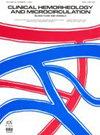Hemodynamics and cutaneous microcirculation during induction of general anesthesia with and without esketamine.
IF 2.1
4区 医学
Q3 HEMATOLOGY
引用次数: 2
Abstract
OBJECTIVE Currently, there are limited data on the effect of macrocirculatory hemodynamic changes on human microcirculation, especially during the induction of general anesthesia (GA). METHODS We performed a non-randomized observational trial on patients receiving GA for elective surgery. In the control group (CG), for GA induction sufentanil, propofol, and rocuronium was administered. Patients assigned to the esketamine group (EG) received additional esketamine for GA induction. Invasive blood pressure (IBP) and pulse contour cardiac output (CO) measurement were performed continuously. Microcirculation was assessed using cutaneous Laser Doppler Flowmetry (forehead and sternum LDF), peripheral and central Capillary Refill Time (pCRT, cCRT), as well as brachial temperature gradient (Tskin - diff) at baseline, 5, 10 and 15 minutes after induction of GA. RESULTS 42 patients were included in the analysis (CG n = 22, EG n = 20). pCRT, cCRT, Tskin - diff, forehead and sternum LDF decreased following GA induction in both groups. IBP and CO were significantly more stable in esketamine group. However, the changes in the microcirculatory parameters were not significantly different between the groups. CONCLUSIONS The addition of esketamine for GA induction warranted better hemodynamic stability for the first five minutes, but had no significant effect on any of the cutaneous microcirculatory parameters measured.全麻诱导过程中的血液动力学和皮肤微循环。
目的:目前,关于大循环血液动力学变化对人体微循环的影响的数据有限,尤其是在全麻诱导过程中。方法:我们对接受全麻选择性手术的患者进行了一项非随机观察性试验。对照组(CG)采用舒芬太尼、丙泊酚和罗库进行GA诱导。被分配到艾司氯胺酮组(EG)的患者接受了额外的艾司氯胺酮GA诱导。连续测量有创血压(IBP)和脉搏轮廓心输出量(CO)。使用皮肤激光多普勒血流测定法(前额和胸骨LDF)、外周和中心毛细血管再充盈时间(pCRT,cCRT)以及基线、GA诱导后5、10和15分钟的臂部温度梯度(Tskin-diff)来评估微循环 = 22,EG n = 20) 。GA诱导后,两组的pCRT、cCRT、Tskin-diff、前额和胸骨LDF均下降。依司他明组IBP和CO明显更稳定。然而,两组之间微循环参数的变化没有显著差异。结论:在GA诱导的前五分钟内,添加爱斯基摩胺可以保证更好的血液动力学稳定性,但对测量的任何皮肤微循环参数没有显著影响。
本文章由计算机程序翻译,如有差异,请以英文原文为准。
求助全文
约1分钟内获得全文
求助全文
来源期刊
CiteScore
4.30
自引率
33.30%
发文量
170
期刊介绍:
Clinical Hemorheology and Microcirculation, a peer-reviewed international scientific journal, serves as an aid to understanding the flow properties of blood and the relationship to normal and abnormal physiology. The rapidly expanding science of hemorheology concerns blood, its components and the blood vessels with which blood interacts. It includes perihemorheology, i.e., the rheology of fluid and structures in the perivascular and interstitial spaces as well as the lymphatic system. The clinical aspects include pathogenesis, symptomatology and diagnostic methods, and the fields of prophylaxis and therapy in all branches of medicine and surgery, pharmacology and drug research.
The endeavour of the Editors-in-Chief and publishers of Clinical Hemorheology and Microcirculation is to bring together contributions from those working in various fields related to blood flow all over the world. The editors of Clinical Hemorheology and Microcirculation are from those countries in Europe, Asia, Australia and America where appreciable work in clinical hemorheology and microcirculation is being carried out. Each editor takes responsibility to decide on the acceptance of a manuscript. He is required to have the manuscript appraised by two referees and may be one of them himself. The executive editorial office, to which the manuscripts have been submitted, is responsible for rapid handling of the reviewing process.
Clinical Hemorheology and Microcirculation accepts original papers, brief communications, mini-reports and letters to the Editors-in-Chief. Review articles, providing general views and new insights into related subjects, are regularly invited by the Editors-in-Chief. Proceedings of international and national conferences on clinical hemorheology (in original form or as abstracts) complete the range of editorial features.

 求助内容:
求助内容: 应助结果提醒方式:
应助结果提醒方式:


